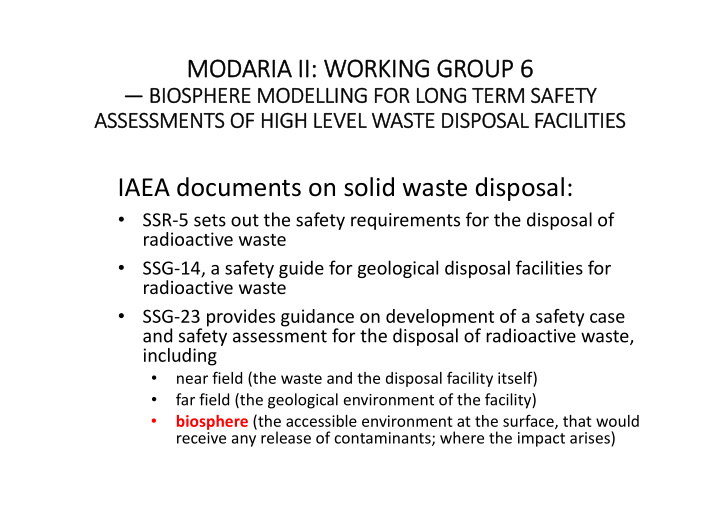



MOD MODARI RIA II: II: WO WORKING GR GROUP OUP 6 — B — BIOSPHERE MODELLI MODELLING NG FO FOR LO LONG TERM TERM SAFETY SAFETY ASSE ASSESSM SSMEN ENTS OF OF HIG HIGH LEVEL LEVEL WA WASTE DI DISPOSAL SPOSAL FACILITIE CILITIES IAEA documents on solid waste disposal: • SSR ‐ 5 sets out the safety requirements for the disposal of radioactive waste • SSG ‐ 14, a safety guide for geological disposal facilities for radioactive waste • SSG ‐ 23 provides guidance on development of a safety case and safety assessment for the disposal of radioactive waste, including • near field (the waste and the disposal facility itself) • far field (the geological environment of the facility) • biosphere (the accessible environment at the surface, that would receive any release of contaminants; where the impact arises)
WORKING GROUP 6 IAEA Bi IA Biospher osphere Modellin lling Me Methodol thodologi ogical al Docum Documents • BIOMASS ‐ 6. Reference Biospheres for Solid Radioactive Waste Disposal, Report of BIOMASS Theme 1 of the BIOsphere Modelling and ASSessment Programme (2003) • TECDOC 1799. Environmental Change in Post ‐ Closure Safety Assessment of Solid Radioactive Waste Repositories. Report of WG3 EMRAS II (2016) • Common Framework for Addressing Climate Change and Landscape Development in Post ‐ Closure Radiological Assessment of Solid Waste Disposal. Report of WG6 of MODARIA, submitted to IAEA
WORKING GROUP 6 Dev Developm pmen ents ts in in bi biospher osphere modellin lling since since BI BIOM OMASS ASS ‐ 6 • Experience from examples of practical application of BIOMASS ‐ 6 since 2001 • Experience of site characterisation at real sites ‐ Finland, Sweden, France, Spain, USA, UK, Canada … others… • Science developments, ‐ Understanding of climate change and landscape evolution ‐ Ecosystem understanding and representation ‐ Methods in toxicology and multiple stressors • Mathematical representation of processes • Coherent link to the remainder of the safety assessment ‐ e.g. via the Geosphere ‐ Biosphere Interface • Special models for special radionuclides, C ‐ 14, Cl ‐ 36 and Se ‐ 79 • Wider range of assessment endpoints: ‐ complementary indicators and ‐ those relevant non ‐ human biota • Regulatory development and experience of assessment review
The general aim should be to evaluate, update, WORKING GROUP 6 clarify and as appropriate, extend the BIOMASS ‐ 6 methodology, and deliver a report that: • Describes the biosphere assessment strategy and how it links to the overall safety assessment so as to support transparent evaluation against protection objectives • Builds on the biosphere concept and describes the lessons learned since 2001, including from the BIOPROTA program • Describes supporting information/models needed for dose modelling • Extends consideration to a wider range of geographical environments • Assesses latest science that supports dose modelling and concept • Describes how site understanding functions as basis for model development • Links landscape environmental change (Modaria) to dose modelling
The general aim… cont. WORKING GROUP 6 • Evaluates discharge areas, and how to define areas/volumes of interest corresponding to the protection objectives • Shows how to analyse and address uncertainties and correlations • Examines methods for presenting and communicating results so as to enhance stakeholder confidence • Provides examples of the application of the enhanced Hypothetical radionuclide flow path (Lindborg et al. 2010) methodology
WG6 Format BIOMASS METHODOLOGY OUTLINE • Assessment context • Guidance on critical and other hypothetical exposure groups • Guidance on application of data • Biosphere system identification and justification • Biosphere system principal components • Biosphere system classification • Application to specific examples • Biosphere system description • Procedure for biosphere system description • Biosphere model development Periglacial environment, West Greenland
Proposed scope of activities WORKING GROUP 6 includes: • Deep geological disposal • Near surface disposal • All types of (solid) radioactive waste • Wide range of geographical environments • Taking account of on ‐ going work in the BIOPROTA project on review and enhancement of the BIOMASS ‐ 6 methodology • Legacy sites involving mixtures of contaminated land, old disposal facilities and in ‐ situ disposal • Greater focus on the first few Landscape development data flow chart (Lindborg et al. 2010 thousand years
The biosphere, an integral part of the entire system Join WG6!
Recommend
More recommend